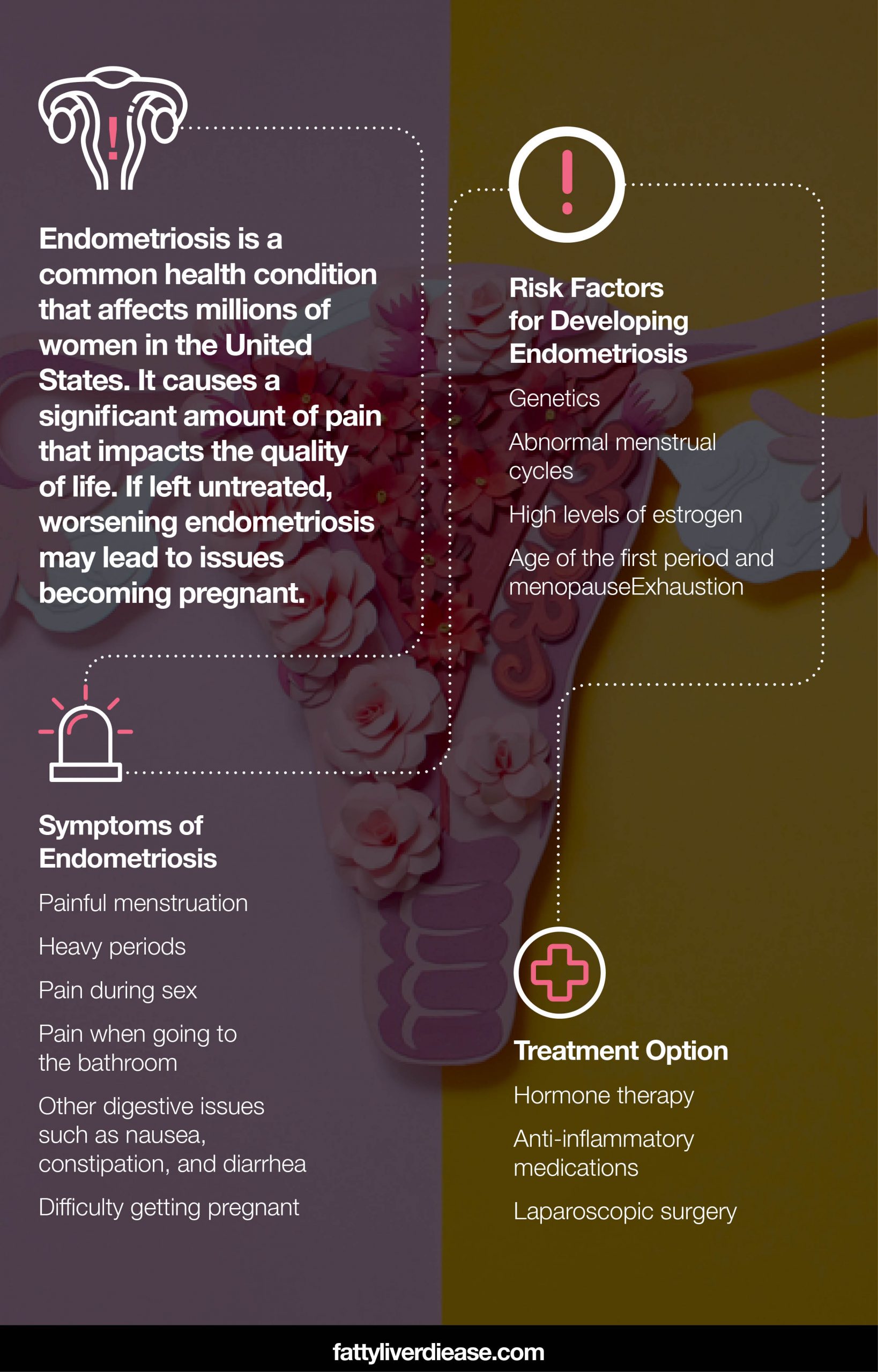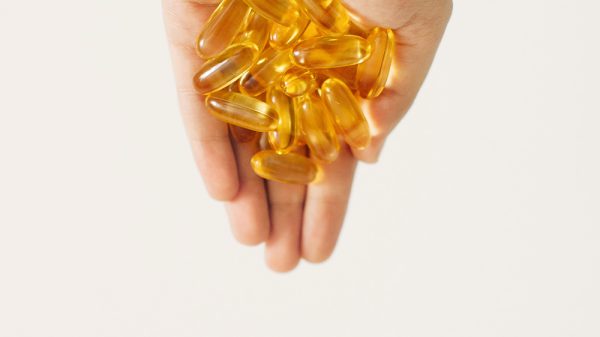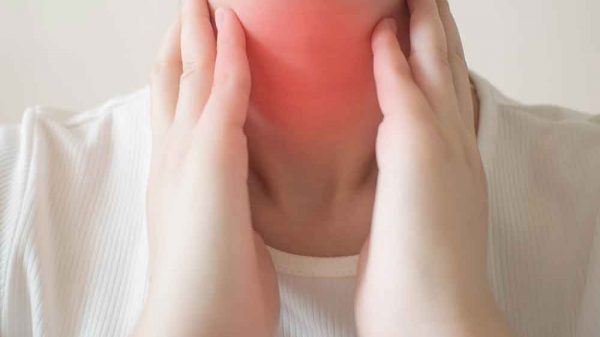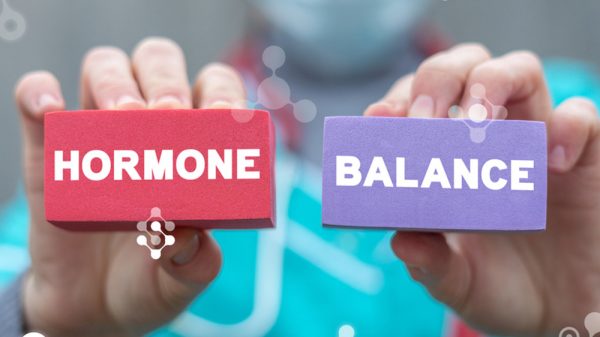Endometriosis is a common health condition that affects millions of women in the United States. Endometriosis causes a significant amount of pain that impacts quality of life. If left untreated, worsening endometriosis may lead to issues becoming pregnant.
So, what are the signs and symptoms of endometriosis? And what does it mean to have endometriosis? We answer all of your questions here. Keep reading to find out more.
Anatomy of the Female Reproductive System
Before diving into the signs, symptoms, causes, and mechanisms of endometriosis, let’s first take a look at the anatomy of the female reproductive system. In contrast to males, the female reproductive system is entirely internal. The uterus is a pear-shaped, pouch-like organ positioned in the pelvic area, in the lower abdomen. The inside of the uterus is lined with a membrane called the endometrium.
The uterus is connected to two fallopian tubes that are located right next to the ovaries. The ovaries are responsible for housing eggs. During puberty, the body matures, and the menstrual cycle begins. Each month, an ovary releases an egg that travels down the fallopian tube to the uterus, where it waits to be fertilized. Over this time, the endometrium thickens in preparation to host a fertilized egg and support embryonic and fetal growth. If the month passes and the egg is not fertilized, the uterus will shed the endometrial tissue during menstruation, colloquially known as a period or “that time of the month.” During menstrual periods, endometrial tissue and blood will leave the body through the vaginal canal.
Endometriosis results from abnormalities in the growth of the lining of the uterus or endometrial tissue. Keep reading to find out the symptoms of endometriosis, how it’s diagnosed, and how it is treated.
Symptoms of Endometriosis
The symptoms of endometriosis are excruciating and can seriously affect a woman’s quality of life. At the same time, many women may overlook some of the symptoms as a normal part of their menstrual cycle and delay seeking diagnosis and treatment.
Common symptoms of endometriosis include:
- Painful menstruation: Many women with endometriosis experience intense pelvic pain during their periods that they may pass off as severe cramping. Severe pain during menstruation is also referred to as dysmenorrhea. Many women pass off this severe pain as normal menstrual cramps that are experienced during menstrual periods.
- Heavy periods: If your period lasts for longer than a week and consistently bleeds through sanitary items, this is a sign that you may have endometriosis.
- Pain during sex: Having intercourse may cause a significant amount of pain, which is abnormal and a sign of endometriosis.
- Pain when going to the bathroom: Painful urination and painful bowel movements are commonly associated with endometriosis.
- Other digestive issues: Nausea, constipation, and diarrhea are not uncommon side effects of endometriosis.
- Difficulty getting pregnant: Infertility can be a sign of an undiagnosed issue, such as endometriosis.
- Exhaustion: The inflammation and pain associated with endometriosis can cause exhaustion and fatigue, as well as other nonspecific symptoms like brain fog and bloating.
Can Endometriosis Cause Weight Gain?
Though weight gain is not a direct impact of endometriosis, it may be a symptom associated with the inflammation and hormonal imbalance common in endometriosis.
Causes and Mechanism of Endometriosis
So, what is the cause of these painful symptoms? The cause of endometriosis has yet to be pinpointed, but there are numerous proposed mechanisms behind the horrible pain and symptoms associated with endometriosis. In the case of endometriosis, endometrial tissue begins growing in areas outside of the uterus, such as the fallopian tubes, ovaries, and other areas within the pelvic cavity. Sometimes, endometrial cells may grow on the tissues of the bowel, bladder, and other abdominal and pelvic organs. During your period, when the uterus is shedding its lining, these small pieces of displaced endometrial tissue also begin to bleed, causing immense pain.
Over time, these endometrial growths cause inflammation in the surrounding tissues as well as the development of scar tissue. In some cases, an endometrial cyst may form. These cysts are filled with blood and fluid that have formed a small cyst because the endometrial cells and waste products do not have an outlet to exit the body. Ovarian cysts often form as a result of the buildup of endometrial growths and tissue.
The exact mechanism behind the growth of endometrial tissue outside of the uterus is largely unknown. However, there are several theories and contributory factors.
- Estrogen: Having too much estrogen may cause undifferentiated cells in the bone marrow to become endometrial cells, which begin to grow in abnormal places.
- Retrograde menstruation: In normal menstruation, blood and endometrial tissue flow out of the uterus through the vaginal canal. In retrograde menstruation, some shed tissue flows through the fallopian tube and leaks into the abdominal cavity. However, retrograde menstruation tends to be significantly more common than endometriosis, which means there are likely other factors at play.
- Immune system and hormonal dysfunction: A hormonal imbalance or immune system dysfunction may allow peritoneal cells outside of the uterus to become endometrial cells and exhibit endometrial behavior. Immune system dysfunction would also inhibit the immune system from recognizing and preventing the development of abnormal endometrial growths.
Risk Factors for Developing Endometriosis
Are there any risk factors that increase the chances of developing endometriosis? The Mayo Clinic describes several risk factors that seem to increase your chances of developing endometriosis. (1)
- Genetics: Having a family history of endometriosis increases your risk of also developing endometriosis.
- Abnormal menstrual cycles: If your menstrual cycles are shorter than 27 days, this is considered a risk factor for developing endometriosis. On top of that, heavy periods lasting longer than a week also signify a higher risk for endometriosis.
- High levels of estrogen: Having high levels of estrogen for a prolonged period of time seems to be associated with a higher risk of developing
- Age of the first period and menopause: Having an early first period or going through menopause late seems to be associated with a higher risk of developing endometriosis.
Diagnosis
Gynecologists are physicians that specialize in women’s health and the health of the female reproductive system. Gynecologists can diagnose and treat endometriosis. Endometriosis is difficult to diagnosis since it occurs completely within the body. As a result, imaging and, in some cases, laparoscopy is critical to achieving a correct diagnosis. A gynecologist will examine your pelvic area to feel for any growths that may have developed. A specialized ultrasound or magnetic resonance imaging (MRI) can be used to view endometrial growths, though they still may miss smaller growths.
Laparoscopy involves making a small incision in the abdomen and inserting a small instrument called a laparoscope into the pelvic area. The laparoscope contains a tiny camera that can depict images of the inside of the pelvic area, allowing the surgeon to visualize abnormal endometrial growths.
Without an examination, physicians are relying on symptoms to diagnose endometriosis. It can be challenging to diagnose endometriosis without imaging tests because, in some cases, symptoms tend to overlap with pelvic inflammatory disease or digestive disorders such as irritable bowel syndrome or inflammatory bowel disease.
Endometriosis Treatment Options
Thankfully, there are many methods for treating endometriosis and managing pain.
Most commonly, hormonal interventions like birth control pills are prescribed to help regulate hormonal fluctuations. As a result, endometrial tissue build-up throughout the menstrual cycle is kept at a minimum. Periods become lighter, shorter, and significantly less painful. In many cases, menstruation ceases altogether, which is beneficial for endometrial symptoms.
Besides hormone therapy, other medications that impact gonadotropin-releasing hormone or inhibit aromatase help lower the amount of estrogen in the body to manage endometrial symptoms.
Laparoscopic surgery is also an attractive method for removing scarring as well as endometriomas or endometrial cysts. Many times, laparoscopic surgery will occur at the same time as a diagnostic laparoscopic procedure is performed. Usually, your physician or surgeon wants to ensure that you don’t need two surgeries. So, they will conduct the diagnostic laparoscopy, and if endometrial growths are found, they will be removed immediately.
In very severe cases of endometriosis among women who are not planning to have children or are older in age, a hysterectomy may be the best course of treatment. A hysterectomy involves removing the uterus. This lowers the chance of endometrial tissue traveling throughout the abdominal cavity.
In addition to hormonal treatments, anti-inflammatory medications like NSAIDs may help reduce pain and inflammation associated with endometriosis. In particular, ibuprofen is an effective medication for managing the pain that accompanies endometriosis. Warm compresses or warm baths may also help relieve pain.
Is There Anything You Can Do at Home to Support Endometriosis Recovery?
You can absolutely make diet changes to support your recovery from endometriosis. Diet changes that have anti-inflammatory effects on the bodywork in conjunction with medications to help relieve your symptoms. For example, here are some diet changes you should make to support recovery from endometriosis:
Eat Omega-3 Fatty Acids
Omega-3 fatty acids are healthy polyunsaturated fats that exhibit potent anti-inflammatory activity. You can make sure that you get plenty of omega-3 fatty acids in your diet by consuming fatty fish and certain nuts and seeds. Salmon, mackerel, and sardines are particularly rich in the animal form of omega-3 fatty acids, which are referred to as EPA and DHA. Flaxseed, chia seeds, walnuts, and pecans are rich in the plant form of omega-3 fatty acids, referred to as ALA. omega-3 fatty acids can help soothe inflammation around endometrial growth while also promoting a healthy immune response, which may help prevent the development of further endometrial growths.
Get Lots of Fruits and Veggies
If you have endometriosis or really any inflammatory condition, fruits and veggies are your friends. The vitamins, minerals, and antioxidants in fruits and vegetables play a role in reducing inflammation, fighting against oxidative stress, and improving the immune system response. Make sure to incorporate fruits and vegetables into your diet on a daily basis. To get a variety of vitamins, minerals, and antioxidants, aim to eat fruits and vegetables of all colors. For example, cherries, apples, blueberries, kale, oranges, avocado, cauliflower, squash, and beets represent a wide range of colors and micronutrients.
Potent Antioxidants
Polyphenols found in green tea and specific fruits and vegetables effectively improve immune response and cell function, which helps prevent the development of endometrial growths. The polyphenols EGCG (found in green tea) and resveratrol (found in red grapes and pomegranate) help tighten the junction in the extracellular space, making it less likely that cells will stray from their original position. As a result, endometrial cells will be more likely to stay within the endometrium rather than traveling to the ovaries, fallopian tubes, and abdominal cavity to create growths.
Get Enough Protein
Getting enough protein may help balance your immune system response as well as your hormones. Protein is made of essential amino acids, which the body requires daily to function optimally. Essential amino acids are vital to helping your body synthesize muscle tissue, neurotransmitters, hormones, and connective tissue. Essential amino acids also provide the raw material that the immune system needs to fight against pathogens and harmful cells, as well as to exercise anti-inflammatory activity.
To get plenty of essential amino acids in your diet, focus on lean protein such as chicken and fish. Tofu and other soy-based proteins can also provide lots of essential amino acids. Still, it’s imperative to combine plant-based protein sources, especially if you are relying on plants as your primary source of protein. For example, serve a bean dish with brown rice or serve a tofu stir-fry with quinoa.
Steer Clear of Junk Foods
Junk foods typically contain ingredients like saturated fat, added sugar, and preservatives. These components exacerbate inflammation in the body and contribute to metabolic conditions such as weight gain, obesity, insulin resistance, type 2 diabetes, and fatty liver disease. The inflammation triggered in the body in response to these foods can easily throw off a delicate balance of female hormones and contribute to the growth of endometrial cells and abnormal parts of the abdomen.
Plus, eating meat and dairy products that are high in hormones may also negatively influence hormones and contribute to endometriosis. To keep your junk food consumption at a minimum, stay away from cakes, cookies, fried foods, restaurant foods, fatty cuts of meat, fatty cheeses, and soda. Cutting out or limiting animal products, in general, is also a good idea since dairy and meat cause inflammation.
What Happens If Endometriosis Is Left Untreated?
If you have a very severe case of endometriosis, infertility is a possibility. Scarring in the ovaries or fallopian tubes may inhibit pregnancy. However, surgical removal of growths or cysts usually is effective in restoring fertility. It’s also important to note that hormonal medications used to manage endometriosis symptoms do not affect your ability to get pregnant after they are discontinued.
In more rare cases, severe endometriosis may impact the reproductive organs more seriously. However, fertility techniques like in vitro fertilization help produce a pregnancy.
When to Visit a Doctor
If you have noticed that you have any of the endometriosis symptoms, it’s a good idea to go in and get checked by a gynecologist. Having painful periods doesn’t necessarily mean that you have endometriosis. However, it’s a good idea to check just in case. The earlier endometriosis is diagnosed, the easier it is to treat. Your gynecologist will be able to conduct all necessary exams and tests and prescribe a treatment plan tailored to your needs.
Conclusion
Endometriosis is a painful condition that affects many women across the United States and around the world. Accurate and early diagnosis is the key to managing endometriosis symptoms effectively and to prevent worsening of the condition. If you have any of the signs or symptoms of endometriosis like painful periods, prolonged periods, and pain during intercourse, it’s a good idea to make an appointment with your doctor. Your health care provider will be able to provide a diagnosis and treatment plan.

References:
(1) https://www.mayoclinic.org/diseases-conditions/endometriosis/symptoms-causes/syc-20354656























